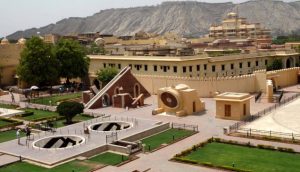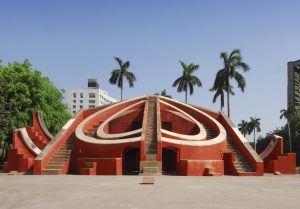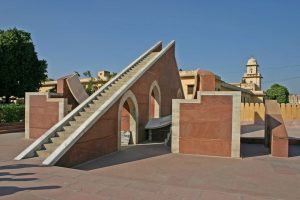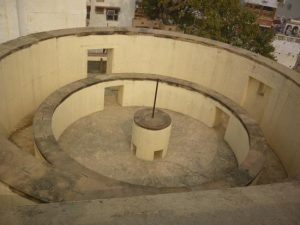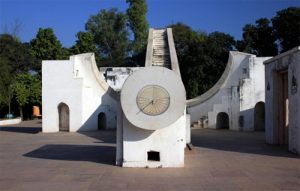Jantar Mantar is an equinoctial sundial. It has a gigantic triangular gnomon with the hypotenuse parallel to the Earth’s axis. Either side of the gnomon is a quadrant of a circle, parallel to the plane of the equator. The instrument is used to measure the time of day, correct to half a second and declination of the Sun and the other heavenly bodies.
There are five Jantar Mantar monuments in India, Jaipur is the largest of all and features many instruments along with the world’s largest stone sundial. The Vrihat Samrat Yantra, a sundial that can give the local time to an accuracy of 2 seconds. It is also a UNESCO World Heritage Site.
Jantar mantar in jaipur
HISTORY
In the early 18th century, Maharaja Jai Singh II of Jaipur constructed five Jantar Mantars namely at
- New Delhi
- Jaipur
- Ujjain
- Mathura
- Varanasi
They were completed between 1724 and 1735.
All the five janitor mantars have names like Samrat Yantra, Jai Prakash, Ram Yantra and Niyati Chakra; each of which are used to for various astronomical calculations. The primary purpose of the observatory was to compile astronomical tables and to predict the times and movements of the sun, moon, and planets.
The name “Jantar Mantar” is at least 200 years old. The first mention about the same was made in the year of 1803. The archives of Jaipur State, such as accounts from 1735 and 1737–1738, do not use this as Jantra, which in the spoken language is corrupted to Jantar.
The word Jantra has derived from yantra an instrument, while the suffix Mantar is derived from mantrana which means to either consult or calculate. The words Jantar and ‘mantar (or yantra and mantra) precisely means calculation instrument.
JANTAR MANTAR: JAIPUR
The monument in Jaipur, Rajasthan is a collection of nineteen architectural astronomical instruments. It was built by the Rajput king Sawai Jai Singh II and completed in 1734 century. It houses the world’s largest stone sundial and is a UNESCO World Heritage site.
It is located near City Palace and Hawa Mahal at Jaipur, the monument also has masonry, stone and brass instruments that were built using astronomy and instrument design principles of ancient Hindu Sanskrit texts. The instruments allow the observation of astronomical positions with the naked eye. The monument expresses architectural innovations, as well as the coming together of ideas from different religious and social beliefs in 18th-century India.
It features instruments operating in each of the three main classical celestial coordinate systems: the horizon-zenith local system, the equatorial system, and the ecliptic system. The monument was damaged in the 19th century. Early restoration work was undertaken under the supervision of Major Arthur Garrett, a keen amateur astronomer, during his appointment as Assistant State Engineer for the Jaipur District.
JANTAR MANTAR: DELHI
In 1858, the Jantar Mantar at Delhi was damaged because of the fighting during the Indian Rebellion of 1857. It consists of 13 architectural astronomy instruments. There is a plaque fixed on one of the structures in the Jantar Mantar observatory in New Delhi that was placed there in 1910 mistakenly dating the construction of the complex to the year 1710. Though research suggests that 1724 was the actual year of construction.
The primary purpose of the observatory was to compile astronomical tables and to predict the times and movements of the sun, moon, and planets. Some of these purposes nowadays would be classified as astronomy.
In 1724, the Delhi Jantar Mantar was completed and had decayed considerably by 1867. The Ram yantra, The samrat Yantra, Jayprakash yantra and The mishra yantras are the distinct instruments of Jantar Mantar.
JANTAR MANTAR: MATHURA
Smaller observatories were built in Benares, Ujjain, and Mathura. Of the five observatories, all except the observatory at Mathura still exist and are publicly accessible. The Mathura observatory and the fort in which it was housed were demolished just before 1857.
JANTAR MANTAR: VARANASI
Jantar Mantar is a popular and well-known place in Varanasi. It is situated above the high water level of Ganges, on the roof of the Man Mahal Palace, near to Dashashwamedha Ghat. It is 7 km from Banaras Hindu University and 6 km from the Varanasi railway station. This astonishing place illustrates the advancements in science and astrology in India.
This place was built in order to see the exact time as well as movements of planet and stars through advanced mathematics, statistics, and astrology. This monument has a specialty to forecast the solar and lunar eclipses along with sun declination and is also a great place for all the architects, astronomers, and engineers who come and study it.
JANTAR MANTAR: UJJAIN
Maharaja Jai Singh II of Jaipur constructed this Jantar Mantar in Ujjain in the 18th century along with four more at Delhi, Jaipur, Mathura, and Varanasi. Also known as Vedh Shala, this observatory has various instruments like Shanku Yantra, Digyansha Yantra and Sundial used to for many astronomical calculations such as time of day, positions of Sun, stars, and planets in the solar system.
Jantar Mantar in Ujjain was renovated by Scindias in the early 20th century. Compared the Jantar Mantras of Jaipur and Delhi, the one in Ujjain is built on a smaller scale but it is also supposed to be the oldest of them.
It is the only observatory among all the Jantar mantars that is still in use. Readings using various instruments are still taken to conduct astronomical studies of the movement of heavenly bodies.
Best time to visit Jantar Mantar
Best time to visit this destination is during the months of September- March when the weather is pleasant.
Tips
1. If you are visiting during summers, try to visit this destination during the morning or evening hours.
2. Don’t forget to carry a bottle of water with yourself to keep yourself hydrated.
Interesting facts
- Jantar Mantar is listed on the UNESCO World Heritage list
Jantar means “instrument” and mantar means “formula” or “calculation”, hence Jantar Mantar collectively means ‘calculation instrument’
- The Jaipur observatory is the largest and best preserved of the five observatories
- There are fourteen architectural astronomical instruments at Jantar Mantar Jaipur
- Jantar Mantar Jaipur can be entered on a composite ticket which includes entry into Hawa Mahal, Amber Fort, Nahargarh Fort and Albert Hall Museum over two days


